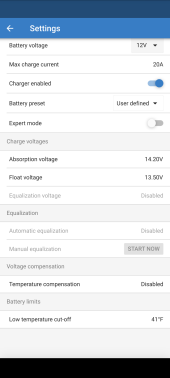Mike Wilson
New Member
- Joined
- Dec 1, 2022
- Messages
- 20
I almost understand peukert exponent.
I do do understand SOC.
I don't understand why when I changed the peukert exponent from factory of 1.25 to recommend 1.01 in my Victron Smart Shunt it lowered the SOC from 75% to 30%.
I can move it up or down with the same results using different values.
400 ah Amperetime Battery
Victron Smart Shunt
Victron Smart Solar Controllers
I just don't understand the correlation.
Thanks Guys.
I do do understand SOC.
I don't understand why when I changed the peukert exponent from factory of 1.25 to recommend 1.01 in my Victron Smart Shunt it lowered the SOC from 75% to 30%.
I can move it up or down with the same results using different values.
400 ah Amperetime Battery
Victron Smart Shunt
Victron Smart Solar Controllers
I just don't understand the correlation.
Thanks Guys.






